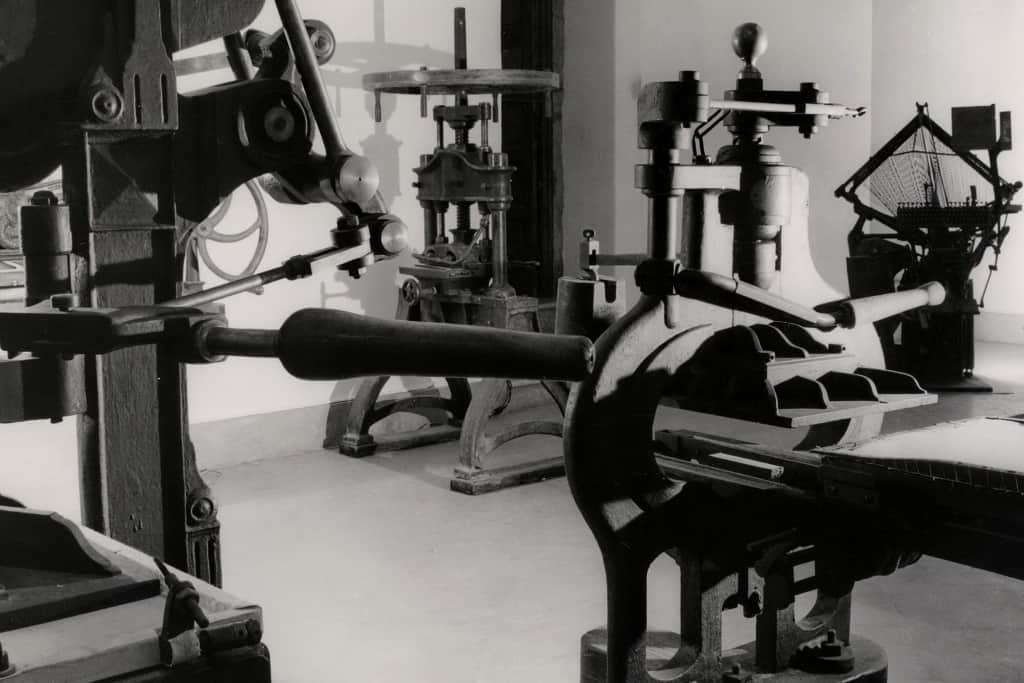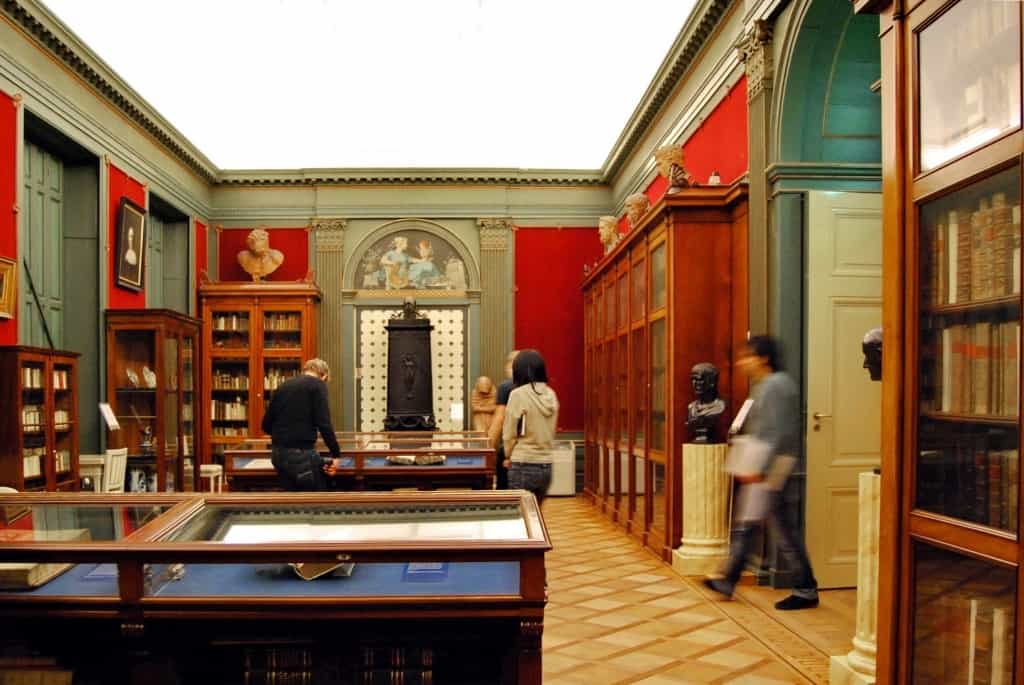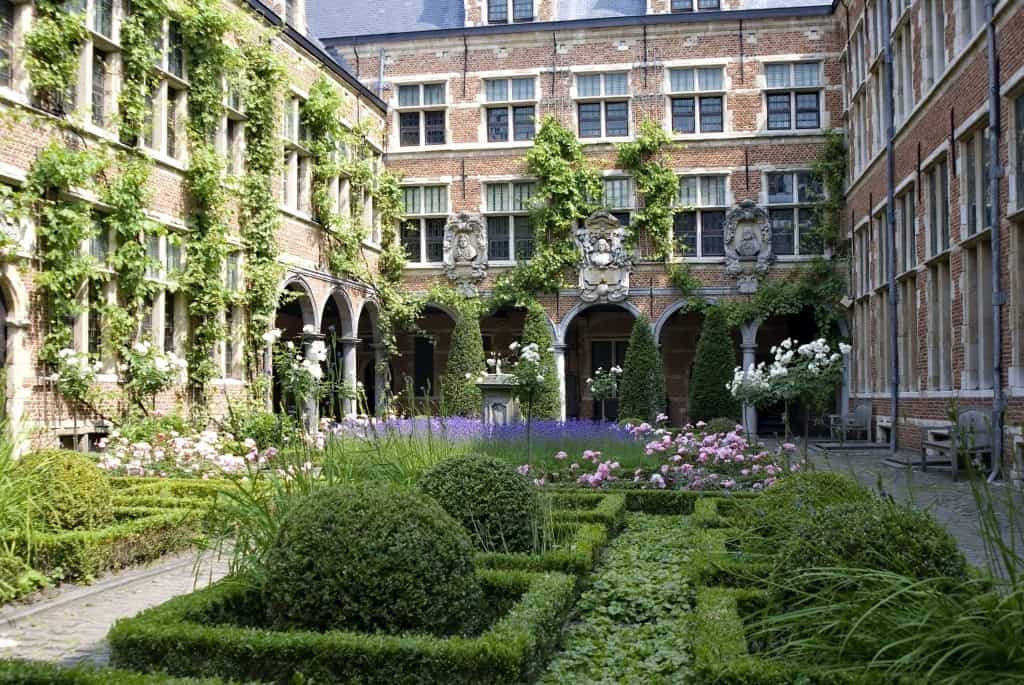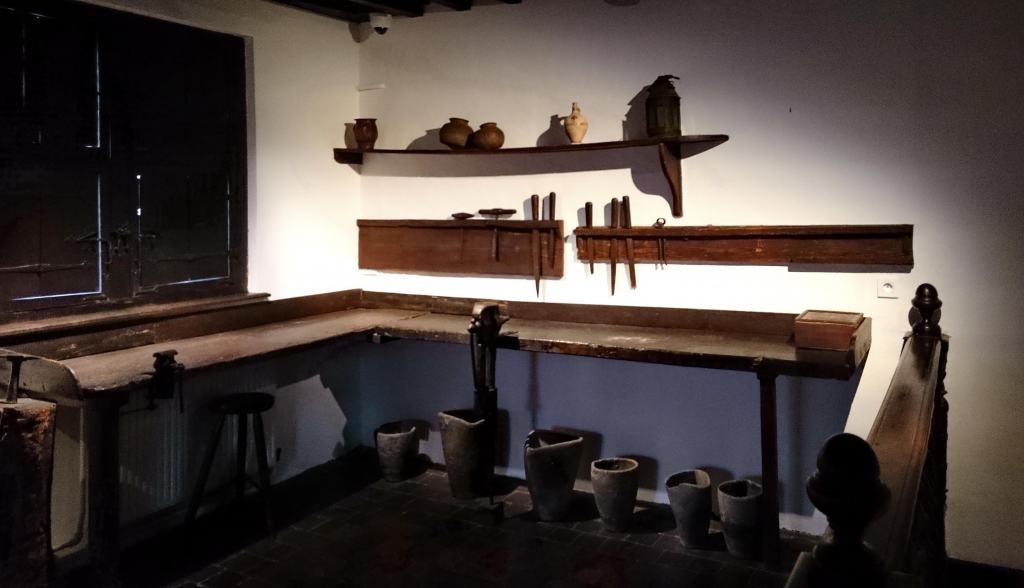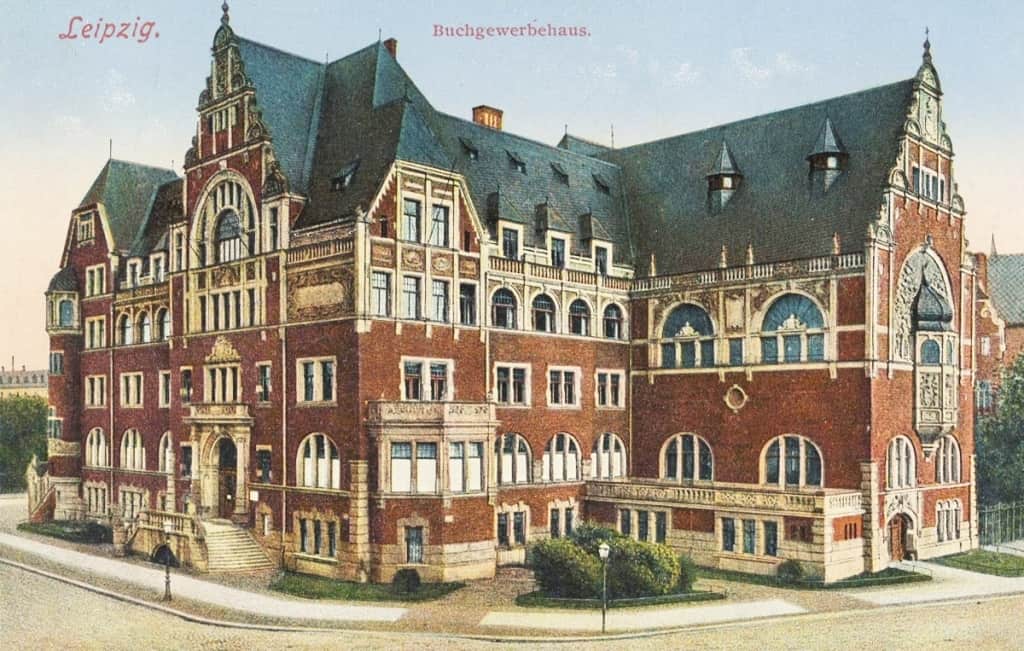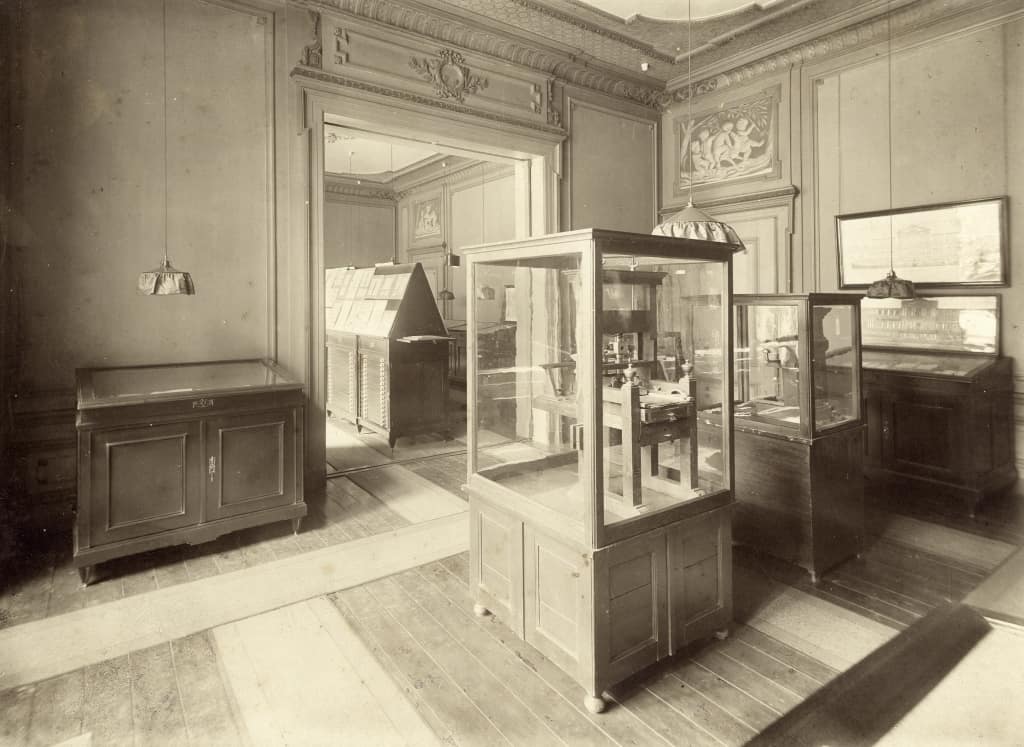Alan Marshall, evokes some early examples of printing museums, the origins of their collections and the motivations of their founders
Like most things, printing museums have a prehistory…
The first institutions to lay claim to the status of ‘printing museum’ date from the end of the nineteenth century. But, that said, they did not just fall out of the sky with the creation of the Plantin-Moretus Museum in Antwerp in 1877 and the Gutenberg Museum in Mainz in 1900. Like most things they have a prehistory which goes back to more ancient times. For printing belongs, by definition, to a much older bibliographical tradition by which books and prints – as well as some other categories of documents of particular historical interest – have attracted the attention of those who seek out, collect and preserve cultural artefacts, whether for personal or institutional reasons.
In the nineteenth century it was something of a novelty to consider the machines and processes of printing as part of our cultural heritage on a par with the many examples of the more prestigious of its products – fine books and prints – which already figured prominently in private and public collections. Such an idea – and with it printing museums – emerged slowly out of the more ancient and generalised respect which had always existed for the more significant examples of printed books and images. There was of course at least one obvious reason for this indifference to the means of production of the principal vehicule for the development and transmission of knowledge and culture in Western society. In the absence of museums – which were few and far between before the middle of the nineteenth century – only the most exceptional historical artefacts related to printing were likely to ever find their way into private collections or cabinets of curiosities. Unlike the select categories of texts and images which had been preserved, transmitted and cherished for centuries (and which in fact represented an infinitely small part of total print production), the everyday tools of the printer’s trade which had remained largely unchanged for over three hundred years were doubtless too familiar to be thought of as part of the cultural heritage of a city, a region or a nation.
Of course the ‘black art’ of printing was not without its admirers. Well before the nineteenth century, the technique of printing had begun to gain recognition, independently of its more prestigious products, as one of humanity’s greatests achievements, an epoch-making technique capable of producing objects which could be both utilitarian and beautiful, a means of preserving and transmitting the knowledge on which the progress of civilization depended. One of the most celebrated formulations of the increasingly respectful attitude towards the ‘useful art’ of printing was expressed as early as 1693 by Jacques Jaugeon in his preface to the Description des arts et mestiers, where he spoke of typography as the ‘art which preserves all others’. [1]
Important as it was as a major contribution to technological progress and as one of the principal vehicules of cultural progress, printing remained above all a practical skill, worthy of being documented and transmitted but not of being collected or exhibited in a cabinet of curiosities, the nearest thing to a museum at the time. Such objects would only really come to be valued as being part of our common cultural heritage in the course of the second half of the nineteenth century. In the meantime, only the more important books and a small number of other printed historical documents could lay claim to a place in the collections of antiquarians, connoisseurs, scholars, libraries and archives.
For these reasons the first examples of what we now commonly call printing museums were, with few exceptions, dedicated principally to the celebration of books, prints and famous print-related personalities.
Books were the earliest and most prestigious form of printing heritage because of the major role they have always played in the transmission of information, knowledge and culture. For over fifteen hundred years the codex had been valued, by some at least, as one of the principal vehicles of ideas and the advance of civilization. Books were not only valued for their content, however. They were also venerated as a symbol of wealth and power. The privileged status of the book – or rather, of particular kinds of books – was expressed through their form, in the endless variety of ways in which their format, typography, page construction, illustration, binding and decoration (both interior and exterior) were used to express not only ideas, but also religious, political, social and intellectual status.
Also, as several authors have pointed out, books contributed to the constitution of what have been called ‘imagined communities’: communities of readers who, through the act of reading, come to share knowledge, culture and beliefs, despite the nature of the act of reading which has become indreasingly individual over the centuries, and the fact that readers generally never encounter each other. [2]
Given the essential role which manuscript and printed books had played historically in Western culture, they naturally occupied a place of predilection in the collections of scholars and connoisseurs – collections that would in due course find their way into, or be the starting point of many public libraries and museums.
Finally, it should never be overlooked that the manufacture and sale of books is a significant economic activity, and so worthy of a form of social respect which compounds its cultural status. Over the centuries books were a major source of income for printers and booksellers, many of whom were respected and sometimes politically influential members of the community.
Alongside books, prints also occupied an honourable place within the canon of legitimate culture, if only because of the venerable age of the medium. The first printed images in the West to be considered for their artistic merits were more or less contemporary with Gutenberg’s invention. At a time when it was current practice for painters to copy the works of the masters, prints were valued both as tools for the study of art history and for teaching. The series production of prints offered accessible models for students who did not always have the means to travel to see the originals. It was also a means of making masterworks known to a broader public. Often valued as works of art in their own right, prints were already to be found in important numbers in the collections of antiquarians, connoisseurs, private libraries and early museums.
It should come as no surprise then to discover that the earliest museums devoted to what we now call printing or graphic heritage were largely dominated by the books and prints which were already such a familial feature of the libraries and collections of scholars, antiquarians and connoisseurs.
There was, however, more to it than that, for the everyday, hands-on, inky-fingered aspects of print production were little by little making a place for themselves in the temples of high print culture. However, full recognition of the essential role which technical artefacts had to play in the development of the first printing museums would not come until the turn of the twentieth century and would require not only new attitudes on the part of museum curators – it would also require major advances in bibliographical studies and in the history of printing and the book.
In the pages which follow (if I may be allowed a paper-based analogy) I would like to evoke some precursors and early examples of printing museums. Unfortunately the full context of their emergence is beyond the scope of such a short article and must remain somewhat sketchy.
Some early printing and book museums
One of the earliest precursors of what we now call printing museums, was the Stanza dei punzoni (punches room) in the Biblioteca Palatina in Parma, Italy, which was dedicated to the preservation and display of the printed works, tools and other typographical material of the celebrated punchcutter and printer Giambattista Bodoni (1740-1813) whose workshop and library had been an attraction for the wealthy and the aristocratic in search of culture on the Grand Tour of Europe in the late eighteenth century. Bodoni owed his success largely to the prestigious work which he carried out for the Duke Ferdinand of Parma and later with the private press which the Duke financed. Bodoni’s output of books was considerable and was designed not simply to be read, but also (perhaps even principally) to be seen and admired. Even more prodigious was his output as a punchcutter, the equivalent of today’s type designer. Curiously enough for a professional working in a sector as little known as typefounding, his workshop with all the accoutrements of the typographical craftsman was an important part of the attraction.
Bodoni’s credentials, both as a craftsman and as a personality, were impeccable and his collection was in due course purchased by the Biblioteca Palatina in 1843 from the heirs of Bodoni’s widow. From its inception, it was intended that people should be able to visit the collection, just as travellers on the European tour had been able to visit Bodoni’s workshop when he had been alive. The initial collection was quickly enriched by the acquisition of Bodoni’s archives in 1846, followed by that of an exceptional collection of his printed works. Though the Stanza dei punzoni was installed as part of a library and not as a museum as such, it is of particular interest because it was dedicated to the memory of one of Europe’s greatest typographers and because it accorded considerable importance to the tools and materials of the highly specialised activities of punchcutting and typefounding which, though essential to the readability and aesthetics of all printed matter, were probably quite unknown to the vast majority of readers at the time who would have been aware of Bodoni rather as a publisher.
The Stanza dei punzo was closed sometime before the Second World War, to reappear again in 1963 still under the control of the Palatina library, in the form of an actual museum, the Museo Bodoniano, which was larger than its predecessor and brought together all the typographical material, archives and printed works of Bodoni. [3]
The first museum dedicated to printing heritage: the Meermanno
One of the very first museums in Europe to be dedicated specifically to printing heritage was the Museum Meermanno, created in 1852 at The Hague in the Netherlands. It was born of a collector’s desire to share his collection and to assure its continued existence.
It was the brainchild of the Baron Willem Van Westreenen de Tiellandt (1783-1848) a rich bibliophile who, having no heirs, bequeathed his collection of 15,000 rare books to the Dutch State on condition that it be used to found a public museum to be installed in his mansion house which he also left to the State. Born into a family of rich bibliophiles (and aldermen of The Hague) the Baron van Westreenen studied law before being appointed assistant royal archivist in 1807. This was doubtless something of a sinecure as he lived principally on the family fortune which allowed him to travel widely in Europe and to build a collection of art works, antiquities and books.
The library and related objects which he bequeathed to the Dutch State on his death – the result of a lifetime of collecting – included a large number of incunables and other early printed works illustrating the spread of printing and the development of the book arts in Europe. The Museum Meermanno-Westreenianum (the name was stipulated in the will) opened in 1852 in the mansion which had been built in the early eighteenth century and which had been occupied by his family since 1794. The Baron, who had lived there alone for many years, also bequeathed his collection of antiquities and furniture which, along with his library, had been a major feature of the mansion. The Museum Meermanno-Westreenianum was thus born of a collection and of its owner’s desire to share it. It was also no doubt the product of the Baron’s personal pride in his exceptional collection and the desire to immortalise a family of illustrious bibliophiles.
Today the disciplines of printing and book history, and the variety of museums in the field are sufficiently broad that we tend to subdivide the already specialist sector of graphic arts museums into even more specialist subdivisions such as printing, book arts, prints, newspapers, graphic design, etc. For that reason,many people would probably think of the Museum Meermanno-Westreenianum as a book museum rather than as a printing museum. In the mid-nineteenth century however, such a distinction would have had little meaning, if only because museums of printing heritage were a novelty and in the minds of most museum visitors (a very restricted category of the population in those days) the notions of printing and books were probably largely interchangeable.
Whatever the category in which we choose to place it, the Museum Meermanno – in contrast to the Stanza dei punzoni which was a special collection within a library – can be considered among the earliest printing museums in Europe, in which Gutenberg’s process of letterpress printing and the many techniques of image reproduction developed over the centuries were at the heart of the fine collection of rare books on display. The technical artefacts of printing would not find a place in the permanent collection of the Museum Meermanno, however, until nearly a century later in the form of the hand press which had been used by the first Dutch private press, De Zilverdistel. The press was acquired in 1942 but was not put on display until 1962 when the Museum Meermanno became the Dutch national book museum.
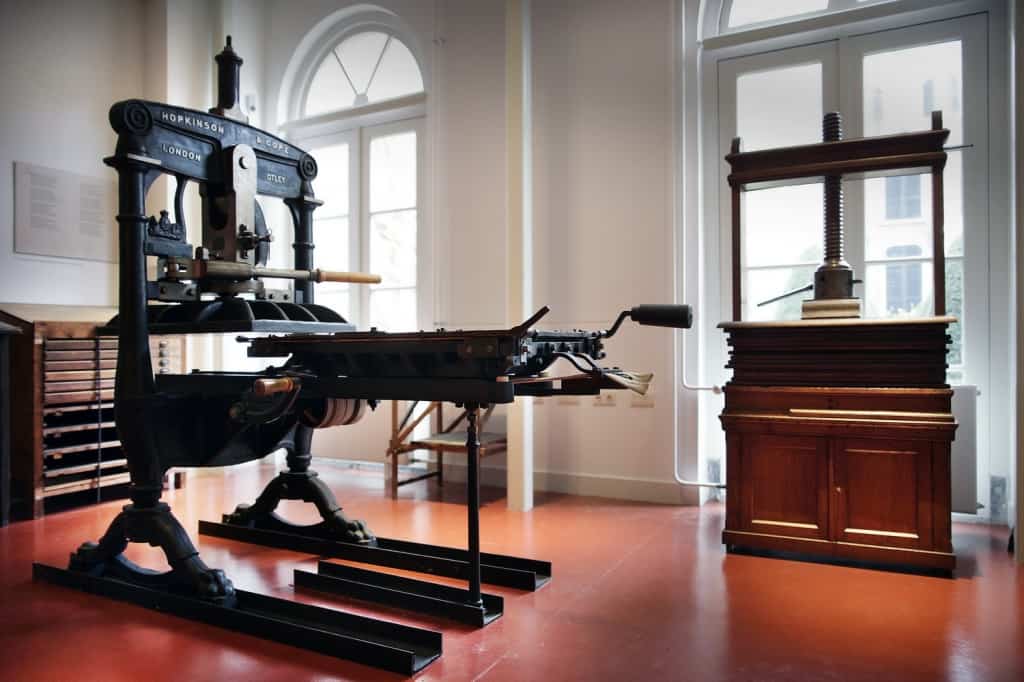
Hand press used by the first Dutch private press, De Zilverdistel, exhibited in the Museum Meermanno, The Hague, Netherlands. (Photo: Frank Jansen, Museum Meermanno.)
The Museum Meermanno was a precursor. It was the first time that a museum had been dedicated exclusively to exhibiting books in their own right rather than as a means of illustrating other subjects, the aim being to show how the book had evolved over the centuries, how it was designed, illustrated, printed and bound, and how the book and Gutenberg’s revolutionary printing process had contributed to the advancement of Western civilization. In line with the nature of its collections, the Museum Meermanno was international and not a museum of Dutch printing or of the Dutch book, the historiography of which would not be seriously undertaken until the closing decades of the twentieth century. [4]
The creation of the Museum Meermanno, though important, was at the time a relatively isolated initiative and it would be another quarter of a century before a veritable printing museum – exhibiting not only books and prints but also the machines and tools of the trade – would open its doors. During this time books and prints would be exhibited principally in the traditional home of the book: libraries.
The first true printing museum: Plantin-Moretus, Antwerp
The Plantin-Moretus Museum opened in 1877, following the acquisition by the Belgian State and the City of Antwerp of the house and workshops of the Plantin-Moretus printing firm. The firm had been founded by Christopher Plantin (1514/1520-1588), one of the leading European printers of the sixteenth century and, in the hands of successive generations of the Plantin-Moretus family, it had continued to play a major role in the commercial and political life of the city of Antwerp until the middle of the eighteenth century when the Spanish authorities withdrew the privileges which had up until then been accorded to foreign printers, allowing them to exercise a virtual monopoly over the Spanish market. The consequences of this decision were dramatic for the Plantin-Moretus firm which found itself reduced to supplying a relatively moribund regional market. The firm never recovered from the loss of its Spanish market and from this time on printing would play a minor role in the diverse commercial activities of the Plantin-Moretus family.
Fortunately for the Moretuses they had been ennobled in the seventeenth century and possessed a considerable fortune made in activities other than printing. However, conscious of the importance of the heritage of Christopher Plantin and of the prestige which it conferred upon the family, they maintained a modest commercial printing and publishing activity, but without making any real effort to keep up with the major technical changes that had come with the Industrial Revolution in order to maintain it as a going concern. As a result, the firm found itself increasingly marginalised in the nineteenth century and, in the mid-1860s, it ceased its publishing activities altogether.
The lack of initiative on the part of the Plantin-Moretus family since the middle of the eighteenth century undoubtedly signed the firm’s death warrant from an industrial and commercial point of view. It was, however, a windfall for printing history because it allowed the firm’s archives to remain intact over a period of several centuries and its workshops and equipment to avoid the effects of mechanisation and industrialisation. Thanks to the family’s commercial inertia, the new Plantin-Moretus Museum possessed one of the richest historical printing collections in the world which included not only the firm’s punches and matrices, woodcuts, engraved copper plates and printing presses, but also the books and prints which had been produced over the centuries and the archives necessary to understand the economic, intellectual and artistic history of the firm’s collection.
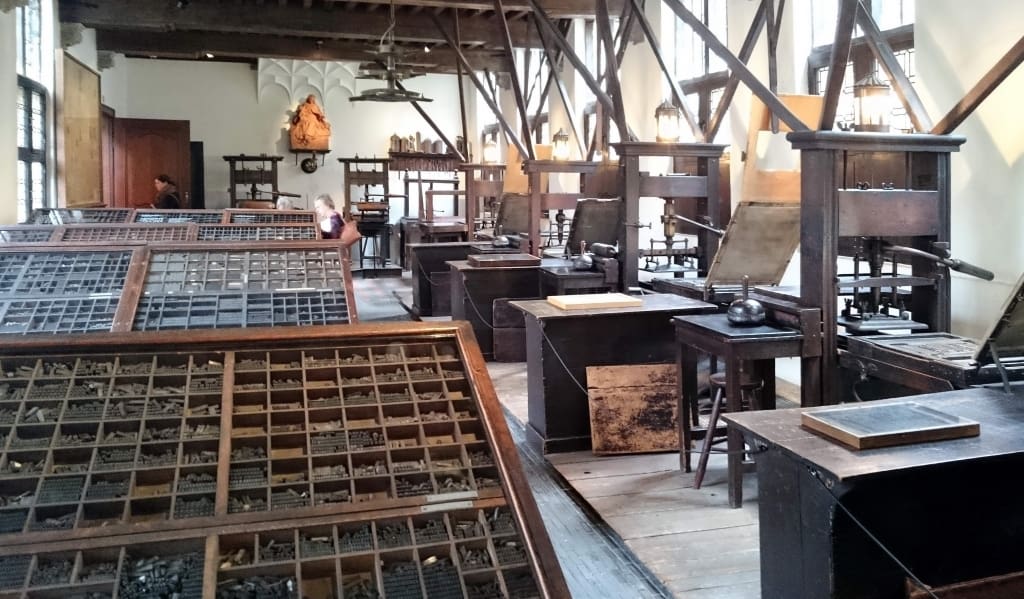
View of the historic sixteenth-century printing presses in the Plantin-Moretus Museum in 2016. (Photo: AM.)
It is also interesting to note that the firm had a certain experience what might loosely be called the museum field well before it closed. Despite its commercial decline, the Plantin-Moretus printing office attracted visitors from all over Europe. Some were prestigious personalities such as crowned heads of state; others were much lesser-known connoisseurs, bibliophiles and booksellers interested in the many fine books and prints produced by the firm. Special keepsakes were even printed for the more important visitors.[5]
Unlike its predecessor the Museum Meermanno in The Hague whose collections were very largely book-oriented, the Plantin-Moretus Museum was a veritable printing museum whose collections included not only a fabulous range of books and prints covering a period of several centuries, but also their technical means of production and the documentation necessary to understand the development of the firm both in the local economic and political context and in the broader framework of European typographical history. Even more extraordinary was the survival of this exceptional collection in its original context: that of Plantin’s home and workshops, complete with the furnishings and works of art which evoked the everyday family environment in which successive generations had lived and worked.
The Plantin-Moretus’s first curator, Max Rooses established the Museum’s reputation both as an internationally-known tourist attraction and as a centre for scholarship on the history of printing and typography, and by the turn of the century the Museum was attracting some 85,000 visitors, including a small number from abroad.[6]
A book trade museum: the Buchgewerbemuseum, Leipzig
Seven years after the creation of the Plantin-Moretus Museum in Antwerp, books and printing again found themselves the centre of attention with the founding of the Deutsches Buchgewerbemuseum (German Book Trade Museum) in Leipzig in 1884. In contrast to the previous examples – the Bodoni typographical collection within a library, Meermanno’s rare book collection donated to create a book museum, and the purchase of the Plantin-Moretus collection to celebrate an exceptional historical figure of both local and international repute – the Deutsches Buchgewerbemuseum was born of a desire to promote the flourishing German book trade centred in Leipzig, and was set up by the institutions of the book trade itself.
The origin of the museum was a report commissioned by several associations representing the German printing and publishing trades. This led to the creation of a joint association covering the entire book trade (Centralverein für das gesamte Buchgewerbe) with the aim of setting up a museum. The first exhibition organised by the projected museum opened on the 12 July 1885 in the great hall of the Buchhändlerbörse, an imposing neo-classical building which had been built in the Ritterstrasse in 1834. It displayed manuscripts, old prints and early lithographs on loan from three private collections – that of Heinrich Klemms (his so-called Bibliographisches Museum), the Apelian library in Ermlitz, and the celebrated printing firm of F. A. Brockhaus – as well as from among the future museum’s own recent acquisitions. Klemm’s exceptional collection of incunabula and prints was purchased for the Deutsches Buchgewerbemuseum a year later.
The Museum was finally installed on a permanent basis three years later, in 1888, in the then premises of the Deutschen Buchhändlerhaus in Hospitalstrasse in the heart of the city’s printing and publishing district.[7]
In this case the creation of the museum was motivated not only by a desire to preserve and exhibit the traditions and heritage of the craft which had done so much to shape Western culture since the Renaissance. Its aim was also to defend and promote the interests of the German book trade of which Leipzig was one of the principal centres. And it is significant that the decision to create the Buchgewerbemuseum was taken the same year that the Centralverein für das gesamte Buchwesen (central association for the book trade) was established with the aim, as the Saxony interior minister put it ‘to promote the graphic arts in Leipzig and assure the City a first rank position in the graphic arts and industries’.[8]
As was the case with the Meermanno and the Plantin-Moretus Museums, the book occupied an important position in the collections and the permanent exhibition of the Deutsches Buchgewerbemuseum. This is of course hardly surprising given that Leipzig was at the time a major international centre in the commerce of the book with many important printers and publishers and a celebrated book fair whose origins go back to the important trade fairs which were held in the City in the Middle Ages. However, in the case of the Deutsches Buchgewerbemuseum the book had to share the limelight with its means of production: the printing trade itself. Indeed, the Deutsches Buchgewerbemuseum was among the earliest examples of what would become a long line of museums with a direct link with the printing trade, an industrial sector which has always been proud of its traditions and of the essential role which it has played in the development of Western society: a pride reinforced by Germany having been the birthplace of typography. The spirit of the Deutsches Buchgewerbemuseum which made no bones about its role in promoting the German printing and book trades was in many respects an extension of the many national and international exhibitions organised in the second half of the nineteenth century at which the graphic industries were regularly, and on occasion massively, present. Likewise, the Buchgwerbemuseum contributed to a more general movement which saw the creation of a wave of scientific and technical museums in Germany at the turn of the twentieth century.
Celebrating the inventor: the Gutenberg Museum, Mainz
Without any doubt the most emblematic of the earliest printing museums is that which was established in 1900 in Mainz, the birthplace of Johannes Gutenberg. Like the Plantin-Moretus Museum it was intended to enhance the prestige of the city by celebrating one of its most famous sons. The Antwerp museum celebrated one of Europe’s foremost printers of the sixteenth century. The Gutenberg Museum went one step further in celebrating one of the most important inventors and inventions of all time. And in celebrating one of the founding events of the modern world, it brought glory not only upon the city of Mainz, but upon the entire German nation. As such it contributed to the construction of the history and identity of what was, in a sense, still a young country, the unification of the German Empire dating from 1871.
The glorification of Gutenberg had been a long process. He had been mentioned as the inventor of typographical printing as early as the fifteenth century, but at that time his reputation was far from assured. In 1540, the centenary of his invention was celebrated in Wittemberg only. (The centenaries are traditionally celebrated in Germany on the fortieth year of each century.) The bicentenary and tercentenaries of the invention of printing celebrated in Leipzig in 1640 (with festschrifts published also in Cologne, Dresden, Breslau and Strasbourg) and 1740 spoke rather of Fust and Schöffer and their ‘assistant’ Gutenberg. It was only in the eighteenth century, in the face of numerous arguments and counter-arguments, that he began to be recognized as the inventor.[9]
The origins of the Gutenberg Museum go back to 1831 when the Verein für Kunst und Literatur in Mainz (Association for Art and Literature in Mainz) initiated a project to commission a Gutenberg memorial. The headed notepaper of the Association included, along with the silhouette of the cathedral and various allegorical figures, the outline of a ‘Gutenberg temple’.
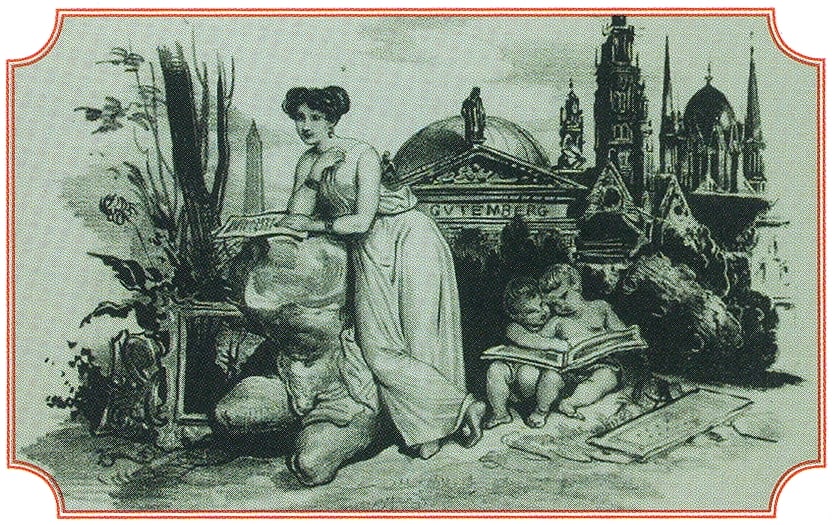
Letterhead illustration of the Verein für Kunst und Literatur in Mainz (1831) as reproduced on the membership card of the International Gutenberg Gesellschaft in 2017.
The Gutenberg Museum as we know it today was established by a group of Mainz citizens under the auspices of the local municipal library. The origin of the project was a commemorative international exhibition to celebrate the 500th anniversary of the supposed birth of Johannes Gutenberg, the exact date of his birth being unknown. The organizing committee of the event laid out the exhibition in three parts: a historical section showing printing equipment and printed products from all periods; a second section providing a panorama of contemporary graphic arts; and a final section dedicated to the latest developments in printing technology. After the exhibition the new Gutenberg Museum – which was the ultimate objective of the organisers – was installed in part of the Kurfürstliches Schloß (Electoral Palace) which already housed the city’s library. The two institutions would move together into new premises on the Rheinallee in 1912. Later, in 1927, the museum would move to its current location in one of Mainz’s most impressive buildings, the Zum Römischen Kaiser built in 1664.
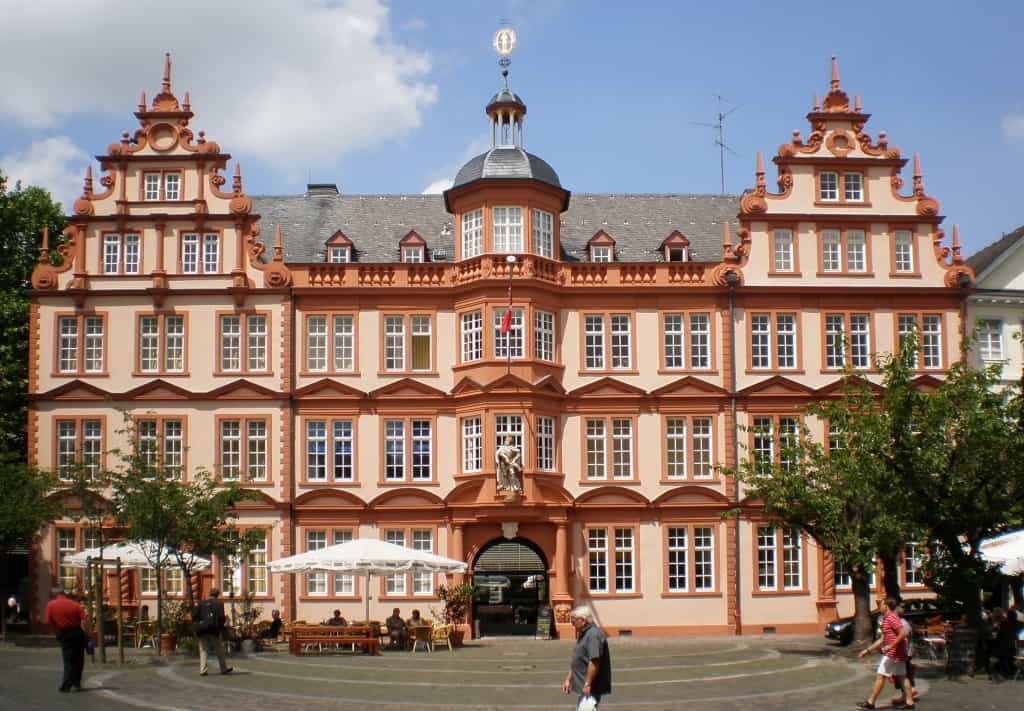
The Gutenberg Museum in the historic Zum Römischen Kaiser which it has occupied since 1927. (Photo: Wikimedia.)
The new Museum received numerous donations from German publishers, printers and printing equipment manufacturers, the idea being that it should be able to offer visitors an overview of five centuries of printing. In reality, however, the permanent exhibition was largely dominated by the printed book. Although the Museum was dedicated to the memory, and the glory, of Gutenberg and the invention of letterpress printing, technical artefacts initially played a relatively small part in its permanent display. It was only in 1925 that the techniques of typefounding and letterpress printing began to acquire greater visibility with the installation of a ‘reconstruction’ of Gutenberg’s workshop including a facsimile printing press inspired by the earliest known illustrations of printers’ workshops. Nothing was of course known about what Gutenberg’s workshop might have looked like or contained, so the construction of the facsimile was largely a matter of conjecture. The purpose of the workshop was to allow visitors to familiarize themselves with the traditional techniques and objects of typefounding and letterpress printing which were still widely used at the beginning of the nineteenth century, despite the advent of mechanisation and industrialisation.
The Mainz Gutenberg Museum was, and remains, the foremost printing museum in Europe and can justifiably lay claim to a truly worldwide reputation because of the importance of the historical personality and the invention which it celebrates, and because of the importance of its collections which include two original Gutenberg bibles. The Museum is also remarkable for the extent of its permanent display which, unlike most of its counterparts in other countries, which tend to be relatively modest affairs, can be compared to that of a moderate-sized fine art or natural history museum.
A company museum: Museum Joh. Enschedé, Haarlem
One other museum should be mentioned among the pioneers because it is probably one of the earliest examples of what we today tend to think of as a printing museum, as opposed to a book museum. It is also of particular interest because it is a company museum.
The Museum Enschedé at Haarlem in The Netherlands was formally established in 1904 as the Enschedé Museum Foundation whose purpose was to preserve all materials pertaining to the history of the firm whose origins go back to 1703 and ‘to store and collect antiques, valuables and relevant curios’.[10] Enschedé was, along with the Luchtmans publishing house (founded in 1683), one of the very few Dutch graphic enterprises whose archives have survived over a long period.
A ‘museum room’ which could be visited by appointment had existed since at least 1897. The company’s records are vague as to when the Museum actually opened, but according to contemporary press reports it was formally inaugurated probably sometime around the beginning of 1913 and was largely the result of the efforts of Charles Enschedé (1855-1919) who perhaps already had in mind the idea of setting up a museum when he published his monumental history of the firm in 1893. Despite the very considerable volume of documentation which has been preserved little is known at present about how the Museum was run up until the Second World War. Various mentions are to be found in the reports of the firm’s board meetings of complaints about lack of space to store the archives and personnel to adequately catalogue them.
From the outset, the Museum Enschedé displayed numerous technical artefacts illustrating the development of printing over a long period. Though the collections were dominated by the Enschedé firm and its activities, the permanent exhibition illustrated the development of printing and the art of typography over the two centuries during which the company had been in existence. Given the importance of the firm and the various other companies which it has acquired over the years, it offered an extensive view of the history of typography in the Netherlands. In 1908, Charles Enschedé would publish a exquisitely-printed scholarly history of the types of The Netherlands: Fonderies de caractères et leur matériel dans les Pays-Bas du XVe au XIXe siècle.
In contrast to the Plantin-Moretus Museum in Antwerp, whose historic presses had come from a firm which had been largely by-passed by technological and industrial progress in the nineteenth century, the Museum Enschedé was created by an enterprise which was not only the repository of an extremely rich collection of historical material but was also an important and thriving industrial printing firm active in some of the most advanced and technically demanding sectors of the printing industry (banknote printing in particular), whose commercial dynamism complemented its pride in its prestigious history.
The Museum Enschedé can however be compared to the Plantin-Moretus Museum inasmuch as it was created by a family with a particularly strong sense of its own history and possessing the means to preserve a very large part of its archives and historical objects. Both families and their respective firms had exercised a considerable influence on the economic development of their home cities and so were presumably not indifferent to the perenity which the museum gave to their memory and reputation.
The printing section of the Czech National Technical Museum
When looking at printing museums in the long nineteenth century, it seems only reasonable to include a printing section in a large technical museum. Just as we looked at the Stanza dei punzo, forerunner of the Museo Bodoniana which might more properly be described as a permanent library display so, as part of an inclusive definition of printing museums, we shall now look at the case of the printing collections of what is now called the Národní technické museum (National Technical Museum) in Prague (Czech Republic). For like many other technical and industrial museums, the National Technical Museum included a section devoted to printing and papermaking from the time it first opened its doors to the public in 1910.[11]
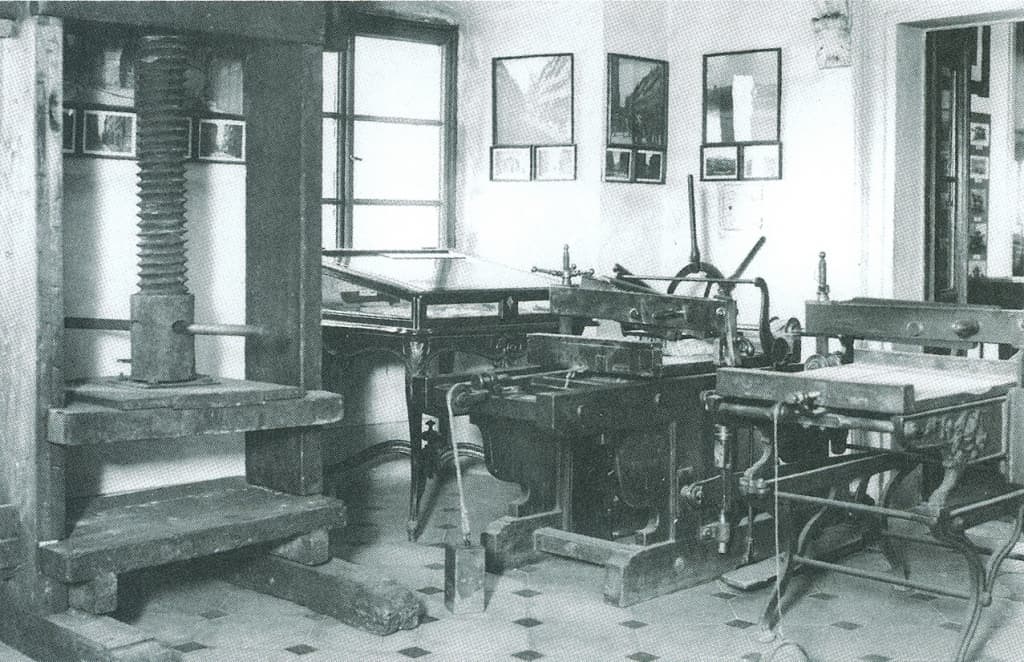
The printing collection of the Technical Museum was displayed in the Schwarzenberg Palace from 1910 through to 1941.
The origins of the National Technical Museum and its printing collections go back well beyond the turn of the twentieth century, and can be traced to 1862 when Adalbert Fingerhut (better known as Vojtĕch Náprstek) formed a committee to create a Bohemian museum of industry which began collecting technical artefacts related to Czech industrial production from all over Europe. Náprstek was a partisan of the nationalist cause, a freethinker and, later advocate of women’s suffrage and had lived in the United States for ten years after fleeing from his home country in 1848 to avoid the displeasure of the Habsburg authorities. This experience doubtless encouraged his interest in all forms of technical progress which he would later advocate as a city councillor in Prague, as well as in his activities as a collector and as an organiser of exhibitions. One of his more notable exhibitions in the 1860s was of household appliances including sewing machines which were virtually unknown in his country at that time. It was only in 1908, however, with the support of professors from the Czech Technical University and the Prague chamber of commerce, that Náprstek’s visionary project for a technical museum finally gave birth to an institution which opened to the public two years later as the Musée technique de prague, Conservatoire national des arts et métiers. It is interesting to note that the supporters of the project were influenced by the technical museums which had recently been founded in Munich and Vienna, as well as by the important industrial exhibition which had been held in Prague in 1891. To begin with the Museum was privately financed and it was only in 1918, when it became the Czechoslovakian Technical Museum, that it was partly subsidised by the recently formed Czech Republic.
The Museum’s original printing collection had been established by Náprstek in the late 1880s with the support of the Prague Book Printers’ Association (Spolek fakrorů pražských knihtiskáren), the Prague society of lithographers and the directors and staff of various printing houses. The printing presses and other equipment which had been collected by Náprstek’s group were on display from the moment the Museum opened in 1910. A year later printing was given a new dedicated display space of its own under the title Polygrafie, and by 1919 a graphic arts section had been formally constututed within the Museum’s collections. Náprstek having died in 1894, the Museum’s printing group was by this time meeting under the leadership of Dr Jaroslav Husník, the son of Jakob Husník one of the pioneers of collotype printing and who was himself commercially involved in industrial three-colour letterpress printing.
Behind the development of the graphic arts section of the Czechoslovakian Technical Museum was the institution’s preoccupation with the promotion of Czech science, technology and industrial innovation which informed its acquisition and exhibition policies. One of the consequences of this was that printing presses occupied a relatively minor position in the collections because there were virtually no Czech manufacturers in this field until much later in the twentieth century. Another was that the Museum actively collected examples of current Czech industrial production, principally in the form of gifts from industrialists who were represented in the Technical Museum’s association. It was thus common to find historical and contemporary techniques represented side by side in the Museum – an approach which was common in industrial exhibitions but which later went out of fashion, only to reappear in museums in recent times. Another particularity of the Museum’s printing collection during this formative period was that it was exhibited in its totality. Or as today’s Catalogue of the printing collections puts it ‘The exhibition was identical to the collection’.
The Czech National Technical Museum was one of many printing sections set up within the new museums of science and technology which sprang up at the turn of the twentieth century. As such it benefitted from a favourable combination of circumstances: the desire to develop a more permanent tool for the promotion of national industry which had been so well served by international expositions in the second half of the nineteenth century; the need to encourage interest and spread knowledge about science and technology which had become the mainstays of nearly all forms of industrial and economic activity; and the instrumentalisation of great inventors and their inventions in the cause of international prestige. Printing was at its apogee both as an industrial process and as the world’s first mass media. In addition, the very foundations of the forms and uses of print in society were being profoundly altered by the advent of industrial capitalism aided and abetted by electrification, photomechanical processes and new communication techniques. What could be better than printing as an example of technological change and its impact on society and culture?
Not all projects succeeded: Musée du livre, Paris 1895
Before finishing with this evocation of some of the pioneer book and printing museums, it is perhaps worth remembering that not all such projects succeded. At the end of the nineteenth century, the position of printing as the world’s first, still uncontested, mass media and the support of numerous influential members of the printing trades were not always enough to guarantee the success of a project to set up a printing museum.
In 1895 a group of professionals involved in the French printing industry got together in Paris with the idea of creating a musée du livre. A society was set up and its statutes published in the trade press. It should be emphasized that the idea was indeed to create a printing museum and not a book museum as the name might at first glance suggest, for in French the term livre (book) was currently used to cover all aspects of printing and not just books. Traditionally the printing industry was (and often still is) generically referred to as les industries du livre, print workers as ouvriers du livre, and of course the printing trade union of the time was the Fédération française des travailleurs du livre.
The managing board of the new Society was made up of a variety of personalities with a direct interest in the printing trade. Victor Breton, as well as teaching at the École Estienne, the leading French printing school which had been established in Paris only six years before, in 1889, was also a prolific writer on all aspects of printing and a close collaborator of the monthly trade journal Les Affiches de l’imprimerie. Other journalists in the group included Arnold Muller of the Annuaire de l’imprimerie, whose address was used by the society, Paul Bluysen, editor of the Revue des arts graphiques, and Desgeorges of the Bulletin des maîtres-imprimeurs, the influential journal of the master printers’ federation. Edmond Morin, another member of the committee, wrote for L’Imprimerie and L’Intermédiaire des imprimeurs and would later publish an authoritative Dictionaire typographique (1903). He would also be at the origin of a foundation for the documentation of printing and the printing industry, based largely on his own library, which would become the Bibliothèque des arts graphiques in Paris in 1929. Another important member of the committee was Auguste Keufer, general secretary of the Fédération française des travailleurs du livre, whose influence with organised print labour complemented that of Desgeorges with the master-printers. Other members of the committee included Desormes, director of the École Gutenberg, two professors from the Ecole Estienne, Georges Lequatre, professor of book history, and the the wood engraver Stéphane Pannemaker (son of François, who illustrated Gustave Doré among others), and the man of letters Henri Gauthier-Villars. The society was nothing if not well connected.
It was an auspicious beginning. The project was based in Paris and had the backing of the trade press, which meant that it should not be difficult to gain the support of rank and file printers and the industry at large. Likewise, the close connections which many of the committee members maintained with leading industrialists, the principal schools of printing and local politicians ought to see to it that the future musée receive the necessary support from officialdom for it to get off the ground.
In addition, the project could hope for material support from an industry which was particularly strong in Paris. Despite the ups and down of economic cycles, printing was in many respects in its golden age, benefitting from technical innovation, rapidly expanding markets and increased productivity. As the first mass media it had as yet little in the way of competition.
It is also possible that the project was at least partly born of the success of the international exhibition which had been organised in Paris earlier the same year to mark the centenary of the invention of lithography by Alois Senefelder. The success of the Senefelder event and of various other printing exhibitions which had been organised as part of previous international expositions in Paris may well have convinced the promoters of the musée du livre that the time had come to establish a permanent exhibition devoted to the history, development and contemporary prowesses of the industries du livre in France.
Despite the initial optimism of the founding group, occasional appeals for machines and other donations, and the enthusiastic support of the trade press, progress was slow. At the time when the group was coming together to promote the creation of the musée du livre, one of the leading trade journals of the time, the Typologie Tucker, commented on the considerable support that it had been able to mobilise among political figures in the months preceding the official announcement of the Society’s existence.[12] Three years later, however, the same journal commented again on the work of the committee, but in a rather less optimistic tone, when it reprinted a remark made by a journalist in the Revue des industries du livre according to which the musée du livre ‘continues to live on hope. It has received many expressions of encouragement, but no more than that’.[13] And in another article later in the same year, the journal reported that the members of the committee had indeed not lost hope, but that the creation of the museum was turning out to be a rather longer process than had been anticipated. Appeals had been made repeatedly to public authorities but had not yet managed to provoke the slightest response.[14]
The journal cited various recently created printing museums in other countries: in New York (the reference was probably to the recently created Grolier Club), in Vienna and in Copenhagen, as well as a major museum which had been created in Leipzig and which, according to the journal had been financed and set up in less than a year! (The author of the article was doubtless referring to the Deutsches Buchgewerbehaus whose exact chronology seems to have got lost in translation.)
By 1905, an unsigned article in the Revue des industries du livre[15] – probably written by Arnold Muller, the chairman of the Société du musée du livre, lamented the project’s lack of progress since the initial enthusiasm of ten years before. In particular he criticised the continuing lack of response from the Paris municipal authorities concerning the proposals the Society had made. Why the silence, he asked. Was it from fear of provoking a reaction from the employers’ associations or the trade unions? Was it due to ignorance about the state of an industry which they mistakenly assumed required no support or promotion because it seemed to be flourishing? (which over the medium term it was, but not without periodic crises). The writer thought that such an attitude might have been encouraged by the dynamism of the bibliophile market at the time – a market which was of course economically marginal and technologically static as compared with the general trade. Such immobility on the part of the political decision-makers was, in the opinion of the columnist, inexcusable in a period of profound technological change when other countries – notably Germany – were making such an effort to modernise and promote their printing industry with a view to maintaining their lead and winning new markets. Describing the trade as being little better the writer ended on a pessimistic note: ‘Divided, the professional organisations are doing nothing. That’s how, on the tenth anniversary of the creation of our Society, Paris still does not have its printing museum, while Leipzig has had one for six years and Brussels is on the verge of having a museum of its own’.[16]
In the following years there were fewer and fewer mentions of the project in the trade press and the Société du musée du livre seemed to have quietly abandoned its efforts. In 1911, however, sixteen years after the creation of the committee, Les Affiches de l’imprimerie reported that though the project seemed to have made little or no progress in the face of the indifference of officialdom, numerous donations had been received, sufficient to form the core of a future museum’s collections.[17] The journal at last reported one positive bit of news. M. Fontaine, the director of the École Estienne had obtain the approval of his managing committee to follow up on a suggestion which Arnold Muller had made some time before, that the school take on the future Musée du livre as part of a veritable ‘maison du livre’ which would include its teaching activities, its technical library, its existing historical collections and the Musée. (Rather like the existing Buchgewrbehaus in Leipzig or the Maison du livre which had been set up five years previously in Brusssels.) Counting on the help of the city councillors who were on the school’s management committee, the next step would be to obtain the support of the City of Paris to whom the school belonged. In return the Société du musée du livre would donate its collection and whatever remained of the funding which it had already raised to the school. It was also hoped that a project on such a scale ought to be able to count on an important influx of further donations. The journalist, (a certain Ol. Reith) concluded energetically: ‘All the foreign capitals have flourishing printing museums. It is unthinkable that the city of Paris, one of the birthplaces of printing, where printing is honoured, not have its own musée du livre’.[18] In 1913, Mr Fontaine retired after nearly fifteen years at the head of the École Estienne. In an article written on the occasion for Les affiches de l’imprimerie, Victor Breton made no mention of Mr Fontaine’s support for the idea of a Musée/Maison du livre, nor of what his successor – Georges Lecomte – might do with the project.[19]
Success and failure of printing museum projects
For the moment the reasons why the projected Parisian printing museum failed are somewhat obscure. Certainly, the Société du musée du livre brought together some very well-connected personalities from the printing world. But who were the real moving forces and who was there simply to look good on the headed notepaper and occasionally put in a good word with their political contacts? One gets the impression from reading the accounts of the project in the press that Arnold Muller and Victor Breton were particularly active in maintaining the visibility of the project in the press and with respect to the political powers, industrialists and the trade. Auguste Keufer and his counterpart from the employers’ organisation, Desgeorges, would probably have had considerable sympathy with the project but little time to give to it in the closing years of the century when the mechanisation of type composition was causing serious disruption among skilled compositors. The teaching staff from the Ecole Estienne and the Ecole Gutenberg would doubtless have been useful in organising the logistics of storage and restoration of machines gifted for the collection and Georges Lequatre had very useful exhibition experience (he would be one of the moving sprits of the 1911 exhibition of printing equipment organised by the federation of printing equipment manufacturers with special responsaibility for the design of the display).[20] But who did the necessary ground work in planning a collection and how it might be exhibited and in maintaining connections with scholars and specialists in printing and book history? Did the project have a strong intellectual focus capable of driving it beyond the initial enthusiasm? This last question is perhaps the most important. For little of the sort transpires in the press reports about the proposed Musée, in contrast to several of the pioneer museums which were discussed previously.
Perhaps the Paris project simply did not manage to make itself heard beyond the albeit important, but restricted circle of the printing trade.
In contrast to the Paris project, the Stanza dei punzo was initiated by an established authority – a heritage library – with a clear mission to promote the memory of one the City of Parma’s most celebrated citizens. It also possesed the very considerable collections of books and technical artifacts which had been acquired from the Bodoni family. In establishing the Bodoni showcase the City could also expect to add to the already considerable prestige of the Palatina Library. However, such clear objectives were no guarantee of success, for the Stanza dei punzo and its successor the Museo Bodoniano have suffered various ups and downs over the years. In Italy the financial resources of heritage libraries are often inversely proportional to the richness of their collections and the Stanza dei punzo lived modestly for nearly a century. It was, after all, only a department – albeit a very prestigious department – of a library and not a museum as such, at a time when libraries generally allocated few resources to the display of their treasures. In addition, its closure to the public sometime in the late 1930s was quickly followed by the disastrous bombardment of the Palatina Library during the Second World War and it was only in 1963 that it reopened, this time as the Museo Bodoniano. But even then, it lived a precarious life, subject to the vagaries of budgets and cultural policies. In the 1980s and 1990s it continued to struggle for resources and was repeatedly refinanced and relaunched. During this time access to the Museum could be something of an obstacle race and visitors in winter would often find their enthousiasm for the treasures of the Bodoni collection tempered by having to walk through unheated rooms.
In the case of the Czech National Technical Museum and its printing collections, the ups and down were at times even more vertiginous that those of the Bodoni Museum. Printers responded enthusiastically to Vojtĕch Náprstek’s project to establish an industrial museum, deciding in 1885 to build an exhibition of their own, backed by several influential Czech printers. The exhibition was installed in a building which had been newly constructed for Náprstek’s Czech Industrial Museum in the courtyard of the U Halánků building and continued to grow over the years to cover many different aspects of printing ancient and modern, exhibiting both machines and examples of printed documents. It also benefited from an important retrospective exhibition (Retrospektivnívýstava) which was organised in 1891 by the Prague Association of Printers and Compositors, strongly supported by local printers. Many of the exhibits were subsequently transferred to Náprstek’s museum on deposit from the printing firms which had lent them for the temporary exhibition. In 1903 the printing department of the Museum was rebuilt and expanded with new exhibits coming from the trade to illustrate the current state of the graphic arts.[21] Then, early in the 1920s Náprstek’s museum was reorganised, keeping only its foreign ethnographic collections while the graphic arts collections were transferred to the Technical Museum which had opened to the public in 1910 in the Schwartzenberg Palace in the city’s Hradčany district. The first permanent display of the Technical Museum’s printing collection opened a year later.
By the 1920s the National Technical Museum had began to concentrate on providing itself with a purpose-built home for its collections, raising hopes for further development of the printing exhibition. Funds were eventually raised and construction began in 1938, but events overtook the project when the German occupation commandeered the unfinished building for the ministry in charge of postal services. To make matters worse the Technical Museum also had to leave the location which its still occupied in the Schwartzenberg Palace for makeshift premises before being closed down in 1944. After the end of the war, in 1948, the Museum managed to reopen, not without difficulty, having recovered part of its purpose-built premises. Three years later the Museum was taken over by the Czech State and acquired the name by which it is known today heralding a period of relative stability and slow development.
The closing of the National Technical Museum’s exhibition in the Schwartzenberg Palace and the German occupation of the new museum building still under construction marked the beginning of a seventy-year period during which the printing collections would disappear off the public scene. When the National Technical museum began to occupy its purpose-built premises in 1948 the printing department did not have any exhibition space, only a repository and a workroom. The collections continued to grow however and to be documented by a series of committed curators and historians under whose influence a more systematic and less opportunitistic acquisitions policy was developed. They also provided the matter for several important exhibitions over the years on themes as varied as the Development of writing technology from prehistory to today, Czech printers yesterday and today (1954), 500 years of Czech letterpress printing (1968) and Lithography for business and pleasure (1996).[22] Then, in the mid 1990s, the printing department of the Friends of the National Technical Museum which had been encouraging the development of the printing collections for several decades, began to actively promote the idea of a new permaent printing section. The occasion finally offered itself with the lengthy renovation of the National Technical Museum’s building which culminated in 2013 with the accomplishment of its dream of bringing all its collections together on one purpose-built site. The printing section was one of the earliest installations in the newly refurbished building and opened in 2011, exactly a hundred years after the original printing display had been created as part of the Technical Museum of the Kingdom of Bohemia, and seventy years after the forced closure of its display in the Schwartzenberg Palace. Today the printing collections occupy an important place among the National Technical Museum’s ‘fourteen unique exhibitions portraying centuries of human ingenuity’.[23]
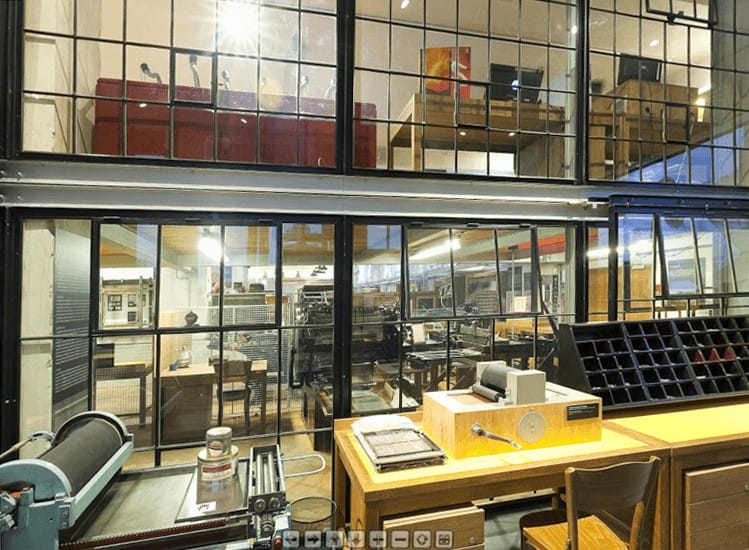
Printing department of the National Technical Museum, Prague.
Of the four other examples discussed here, only one has foundered: the Museum Joh. Enschedé in Haarlem. In many ways it had been a natural outgrowth of the celebrated firm which had built the collection, for its creation was made possible by the financial resources of a successful family-run printing company and the intellectual resources of a family member who was an eminent historian of typography. Since the early twentieth century when the Museum Enschedé was created the economic conditions under which the firm operates have changed considerably, however, and are no longer considered compatible with the maintenance and display of an important historical collection. The Museum was closed to the public in 1990 when the firm completed its move from the historic site at Klokhuisplein to an outlying industrial park, though the firm continued to finance the daunting task of cataloging its collection, albeit with a skeleton staff. Then, in 2014, the archival collections were transferred to the North Holland Archives in Haarlem where they are now in the process of being partially digitised and made available for consultation. As for the historic machines, matrices and punches they are in storage and are no longer accessible, either for the public or for researchers.
As for the three public museums which were established in the second half of the nineteenth century, they are all alive and well. In the case of the Museum Meermanno it had begun with a head start thanks to the posthumous founder who provided a coherent collection which he had built up over a lifetime, as well as part of the material resources necessary for its exploitation in the form of a well-appointed building. Which is not to underestimate the importance of the City of The Hague’s comitment to meeting staffing, maintainance and running costs for ever after. Thanks to its continued support the Meermanno Museum has continued to develop its collections to become the Dutch national book museum in 1962, a status which is not without its own occasional problems. In good times the Meermanno functions as a natural complement to the temporary exhibitions of the Royal Library which is also located in The Hague. In times of budgetary penury its status can become problematic as funding agencies focus on rationalisation and budget savings.
Like the Meermanno, the Plantin-Moretus Museum was also something of an ‘off-the-shelf’ museum, inasmuch as it was created on the basis of a historical collection esablished by an economically and politically influential family. Although the City of Antwerp had to purchase the building and the collection, they were both of inestimable historical value, both for the City’s heritage and for the history of printing and the book in Europe. And like the Museum Enschedé it could be said to be an almost natural outgrowth of a celebrated firm whose collection survived into the late nineteenth century thanks to the financial resources of its owners. The Plantin-Moretus is unique however in one important respect: for its historical importance goes far beyond the limited field of printing history. While its printed collections are easily rivalled by those of many major heritage libraries, and its typographical holdings by a handful of major national collections such at those of the French Imprimerie nationale, no other institution can offer the same depth in terms of its influence on printing history, the quality of its surviving architectural site, and its breadth in terms of the historic firm’s national and international economic reach, not to mention the value of its archives in documenting the interaction of the various aspects of the Plantin-Moretus firm’s activities over several centuries. Indeed the uniqueness of its history and collections was recognised in 2002 when the Museum and its archives became Unesco World Heritage, providing the foundations for a major reorientation of the Museum’s identity in 2016 when the Museum ‘rebranded’ itself as a heritage site rather than as a simple printing museum. This change was in a sense the recognition of the long-established importance of the Plantin-Moretus as a central feature of the City of Antwerp’s cultural heritage. Few other printing museums can claim such an important position within their municipality’s cultural policy: the Gutenberg Museum in Mainz and the Early Printing Museum in Cheongju City (South Korea) being the only others which come readily to mind.
Alan Marshall
![]()
[1] ‘Nous commençasmes nos premiers travaux en mil six cent quatre-vingt treize par l’art de l’imprimerie avec tous ceux de sa dependence, ou qui y ont quelque relation : le fondement de ce choix fut qu’il est le conservateur et comme le depositaire de tous les autres et celuy dont nous auront le plus souvent besoin.’ (Bibliothèque de l’Institut, MS 2741.)
[2] See Daniel J. Boorstin, The Americans: the democratic experience (Vintage Books, New York, 1974) and Benedict Anderson, who coined the term as a means of analysing the development of nationalism, Imagined communities (Verso, London, revised edition 2006).
[3] Andrea De Pasquale, ‘Des musées dans les bibliothèques : le cas des bibliothèques d’Etat en Italie, XIXe – XXe siècle’, Histoire et civilisation du livre, vol. X.,Genève, 2014, p. 234.
[4] According to Paul Hoftijzer and Otto S. Lankhorst the Netherlands did not develop a tradition of honouring its foremost book collectors and bibliographers with the result that, at the end of the twentieth century, Dutch book historiography was still in its infancy despite the importance of printed communication in the political and economic development of the country: though this was probably due at least in part to the relative linguistic isolation of Dutch language research and researchers. Paul Hoftijzer and Otto S. Lankhorst, 1995, p. 140.
[5] Leon Voet: The Golden Compasses, A history and evaluation of the printing and publishing activities of the Officina Plantiniana at Antwerp in two volumes. Volume 1. Christophe Plantin and the Moretuses: their lives and their world, Amsterdam, Vangendt & co, 1969, p. 396-404. Cited by Patrick Goossens in ‘Collecting and the true art of printing’ paper given at the 2017 annual conference of the AEPM, Making history: collections, collectors and the cultural role of printing museums, Chania, Greece, 11-14 May 2017.
[6] Guy Hutsebaut: ‘Museum Plantin-Moretus: storytelling for a new audience with respect for a fragile collection’, talk given at the 2017 annual conference of the AEPM, Making history: collections, collectors and the cultural role of printing museums, Chania, Greece, 11-14 May 2017.
[7] A chronology of the Deutsches Buchgewerbemuseum and the Deutsches Buch- und Schriftmuseum is to be found on the latter’s website at https://www.dnb.de/EN/Ueber-uns/DBSM/Chronik/dbsmChronik_node.html.
[8] Frédéric Barbier, ‘Construction d’une capitale : Leipzig et la librairie allemande, 1750-1914’, in Capitales culturelles, capitales symboliques, Paris 2002.
[9] Martin Lyons: Reading culture and writing practices in nineteenth century France, Toronto, 2008, p. 92-93.
[10] Johan de Zoete in Frans Willem Lantink; Koosje Sierman: Johan de Zoete, Voor stad en staat : Joh. Enschedé 2003-1703 : beelden van driehonderd jaar bedrijfsgeschiedenis, volume 7, Summary, Joh. Enschedé en Zonen, Haarlem, 200
[11] Jana Vánková, Pavel Polreich, Printing. Catalogue of the exhibition, 2018.
[12] Typologie Tucker & circulaire Caslon, n° 305, vol VII, 15 novembre 1895, p.70.
[13] « […] continue à vivre d’espérances. De nombreuses sympathies lui sont témoignées, mais c’est tout ». The journalist was A. Meunier. Typologie Tucker, n° 334, vol VII, 15 avril 1898, p. 537.
[14] M. Montreuil in Typologie Tucker, n° 342, vol VII, 15 décembre 1898, p. 663.
[15] Revue des industries du livre, Paris, n° 103, April 1905
[16] ‘En résumé, le gouvernement n’agit point, soit qu’il ignore, soit qu’il s’illusionne, soit qu’il craigne la critique. De leur côté les groupements syndicaux n’interviennent pas, faute d’union. Voilà comment, après dix ans passés d’existence de notre société, Paris n’a pas encore son Musée du Livre, alors que Leipzig a le sien depuis six ans et que Bruxelles est à la veille de l’avoir.’ Revue des industries du livre, Paris, n° 103, April 1905, p. 5-6.
[17] Les affiches de l’imprimerie, Paris, 15 mars 1911, p. 34.
[18] ‘Toutes les capitals et grandes villes à l’étranger ont depuislongtemps des musées du Livre florissants. Il n’est pas admissible que Paris, un des berceaux de l’imprimerie et où celle-ci est tant en honneur, n’ait pas, elle aussi, son musée de Livre’ Les affiches de l’imprimerie, Paris, 15 mars 1911, p. 34. Almost a century later, a similar projet would be put forward with a view to bringing together the historic collections of the Imprimerie nationale’s Cabinet des poinçons under the aegis of the École Estienne, again unsuccessfuly.
[19] Les affiches de l’imprimerie, n° 89, July-August 1913, p. 271-272.
[20] Victor Breton, Les affiches de l’imprimerie, Paris, n° 69, July-August 1911, p. 102.
[21] Notably Daniel Sluníčko and staff of the Ondřej Haase, Karl Bellman, Jan Otto and Edward & Julius Grégr printing houses in Prague and the papermaker Eichmann in Hostinné. (Vánková, Polreich, Printing. Catalogue of the exhibition, 2018, p. 13-15).
[22] Vánková, Polreich, Printing. Catalogue of the exhibition, 2018, p. 16-17.
[23] Vánková, Polreich, Printing. Catalogue of the exhibition, 2018, p. 7.
